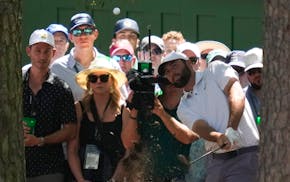Former Twins shortstop Roy Smalley said there was a time, as a player, when he wasn't familiar with the term "pulled hamstring." Ron Gardenhire said there was a time when he had never heard of a strained oblique.
The Twins have yet to complete the second month of the season, yet they have already experienced a baker's dozen's worth of injuries that have tested the patience of their manager, the depth of their farm system and the descriptive phrases in their medical glossary.
Joe Mauer is on the disabled list because of what the team once described as "bilateral leg weakness" and a viral infection, terms with which Mauer does not agree.
Kevin Slowey went on the disabled list because of an acute abdominal muscle strain. Delmon Young missed time because of a strained oblique, Jim Thome to a sore back, Slowey previously to shoulder bursitis, Jason Repko to a strained quadriceps, Glen Perkins to a strained oblique and, really, not only is the newspaper too small to hold the entire list, but the Internet might be, too.
Are today's players really softer or more injury-prone than their predecessors?
That's a question with many answers.
Today's athletes work harder on conditioning than their predecessors. Many of them train year-round, some of them at elite athletic facilities. Higher salaries enable them to concentrate on baseball instead of bill-paying during the winter, and the modern athlete has more information available about training regimens and nutrition.
Thus the modern ballplayer is bigger, faster, stronger, better-trained, and yet seemingly more fragile. Might many of these new-age injuries be the result of over-training?
"I am definitely a proponent of that view," Twins outfielder Michael Cuddyer said. "I have nothing against guys going to those training facilities in the offseason, but I see guys coming to spring training in July shape, in midseason form.
"I'm not going to say you should come in out of shape, but by the time it really is July, your body has been in top condition for six or seven months. Your body thinks it's November.
"I train my rear off in the offseason, but I don't do the types of stuff that other guys do. I think it's possible to overtrain and over-cook your body."
Cuddyer notes that modern-day scrutiny is such that ballplayers worry about showing up to spring training a little overweight. Even if that approach might pay off in August, it might not look good in April. "If you get off to a slow start, then what would people say?" he said.
Many of the Twins' injuries are the result of bad luck: Morneau getting kneed in the head, Tsuyoshi Nishioka breaking his fibula, Joe Nathan requiring Tommy John surgery. Others have happened to people who never have been accused of wimpiness, like Thome.
These days, though, there are more injuries that prompt the raising of eyebrows.
"The bottom line is, if they had played in our era, they would have had a different attitude," Twins broadcaster and former ace Jack Morris said. "We schooled each other. The coaches and trainers and managers didn't have to say anything because everybody else on the team said something to you."
In the Twins clubhouse, there is little peer pressure to recover quickly from injuries. Players might gripe behind a teammates' back; rarely do they address their teammate directly.
The modern ballplayer also belongs to a powerful union and speaks regularly with an agent who reminds him that a big-league athlete on the disabled list receives full pay and accrues major league service time. A player might find it in his best interest to preserve his long-term health and avoid damaging his statistics while playing hurt.
Medical science has progressed along with training, meaning that what once was termed a "sore arm" might now immediately be diagnosed as something more specific and sinister, or a thumb-sized bruise on one's ribs might be termed a an "acute strain."
Language can affect psychology. If you have a cramp in your side, you're not likely to go on the disabled list. If a doctor describes that feeling as a strained oblique, you're out for a month.
The technical term for baseball's waiting room is "the disabled list." For some of these injuries, a better description might be "the enabling list."
"We're giving our training staff all kinds of things to work on," Gardenhire said. "We'll probably get to buy a lot of new machines this year because of it, to work different parts of the body, so there's probably some good coming out of it."
Gardenhire was joking. I think.
Jim Souhan can be heard Sundays from 10 a.m. to noon and weekdays at 2:40 p.m. on 1500ESPN. His Twitter name is Souhanstrib. • jsouhan@startribune.com

Souhan: Why Tiger Woods should keep swinging
Souhan: Scheffler wins Masters again, shows what makes him special
Morikawa falters in final round at Masters

Keeping up with the Joneses who helped design Augusta National's classic back nine

